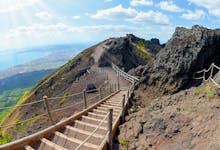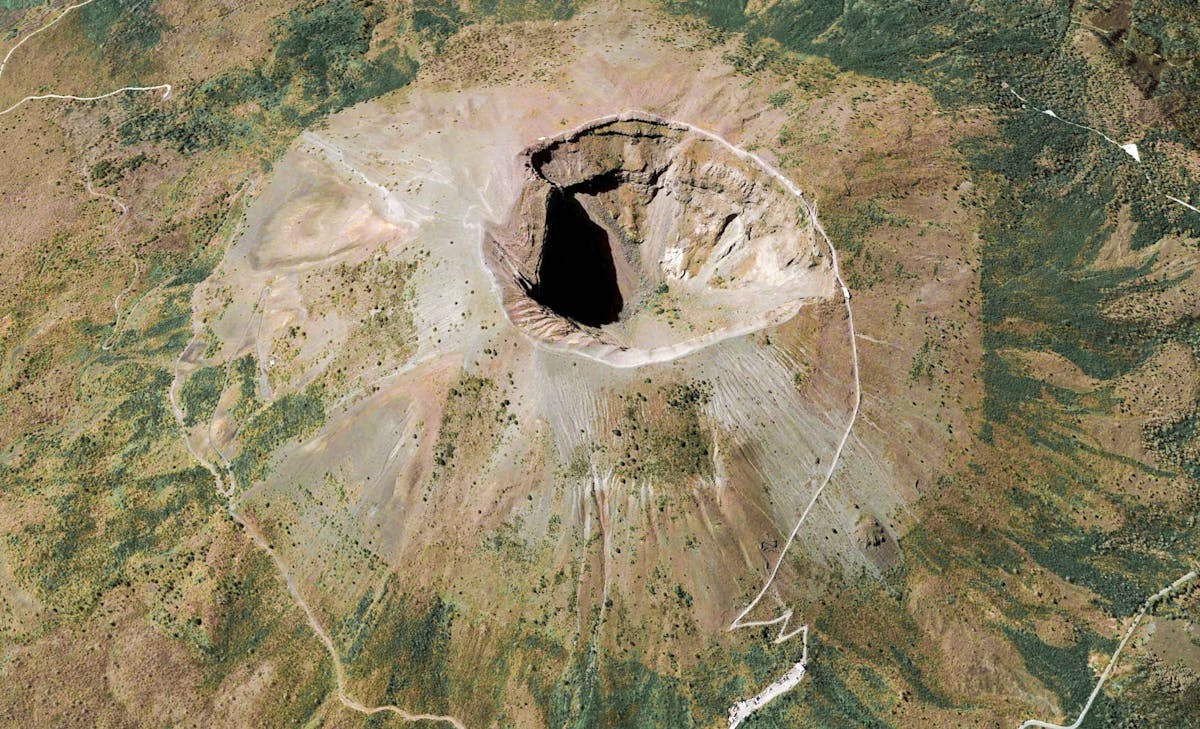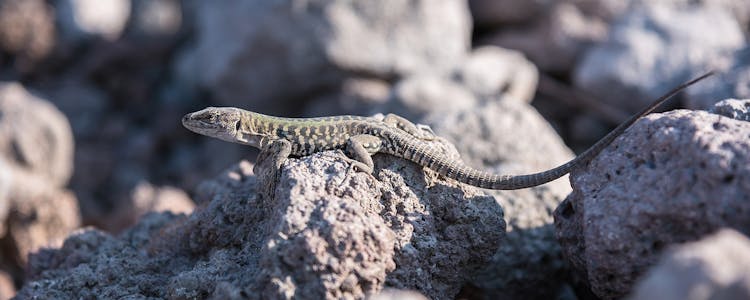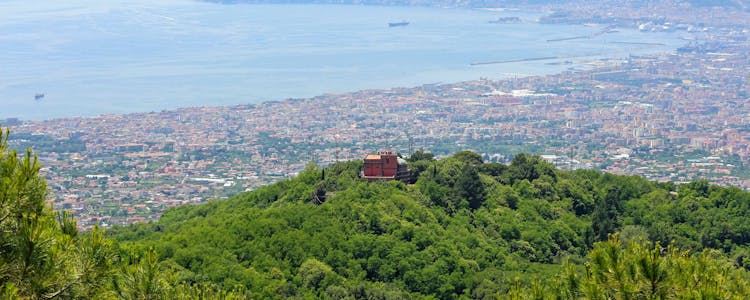Perched on the Bay of Naples, Mount Vesuvius is a stratovolcano with imposing natural wonder. It is famous for its cataclysmic eruption in AD 79, which buried the nearby Roman cities of Pompeii, Herculaneum, and Stabiae in ash and pumice. Today, the mountain remains an active volcano and a symbol of both the region's natural beauty and its geological and cultural history.
Mount Vesuvius in a Nutshell



Getting There
Address
City - Country
Get Directions
Opening Hours
AM to PM,
Closed on XDay
Why is Mount Vesuvius worth visiting?
- Mount Vesuvius is one of the most famous and active volcanoes in the world, with a rich history and cultural significance. It is the only active volcano on the European mainland.
- The views from the top of Mount Vesuvius are truly breathtaking, offering panoramic vistas of the Bay of Naples and the surrounding area.
- The hike to the summit of Mount Vesuvius is an exciting and rewarding experience, offering a challenging trek with stunning scenery along the way.
- The region surrounding Mount Vesuvius is also rich in history and culture, with nearby Pompeii and Herculaneum offering a glimpse into the ancient Roman world.
- In addition to its geological and cultural significance, Mount Vesuvius is also home to a unique ecosystem, with rare plant and animal species found only in this area.
Recommended Mount Vesuvius Tickets
Depending on the kind of experience you seek and time in hand, you can choose from a variety of POI tickets.
Mount Vesuvius History
The history of Mount Vesuvius is punctuated with some of the most catastrophic volcanic eruptions in recorded history. Vesuvius has erupted many times since its first known eruption around 3,900 years ago. Some of the most notable eruptions include:
79 AD: The most famous eruption of Vesuvius occurred in 79 AD when it destroyed the cities of Pompeii, Herculaneum, Oplontis, and Stabiae. The massive eruption released an estimated 100,000 times the thermal energy of the atomic bombs dropped on Hiroshima and Nagasaki in 1945.
1631 AD: In this eruption, Vesuvius spewed out lava, ash, and rocks, killing an estimated 4,000 people.
1794 AD: This eruption caused significant damage to the town of Torre Annunziata and claimed more than 100 lives.
1944 AD: The last significant eruption of Vesuvius occurred in 1944. This eruption caused substantial damage to several towns, and many lives were lost.
Despite its destructive history, Vesuvius has been a source of fascination for people for centuries. It is considered one of the most dangerous volcanoes in the world due to its proximity to heavily populated areas, but it continues to draw visitors from around the world who are eager to witness its raw power and beauty.

Highlights of Mount Vesuvius
1Hiking
Hiking is one of the top highlights of Mount Vesuvius, offering a unique opportunity to explore this iconic landmark on foot. As you trek up the volcano, you'll be immersed in stunning natural beauty, including rugged terrain, lush vegetation, and dramatic vistas.

2Volcanic Wine
Volcanic wine is a unique and sought-after product that can only be produced in a few locations worldwide, and the fertile slopes of Mount Vesuvius are one of them. The soil on the mountain's slopes is enriched with nutrients and minerals from the volcanic ash and pumice, resulting in distinctive flavors and characteristics in the wine produced there.

3Wildlife
One of the most interesting mammals found here is the oaken mouse, which is extremely rare in other parts of Italy. Visitors can also spot other mammals like dormice, beech-marten, foxes, wild rabbits, and hares. The park also has various reptiles, including the colored green lizard, western whip snake, and Turkish Gecko. In addition, over 100 species of birds have been spotted here, making it a paradise for birdwatchers.

4Observatory
The Vesuvius Observatory is an Italian national institution for monitoring and studying the geophysical and geochemical phenomena of Vesuvius and the surrounding area. The observatory is equipped with seismographs, tiltmeters, and gas monitoring instruments that measure changes in the volcano's activity. The observatory also has an important educational role, as it provides information to the public about the history and geology of Mount Vesuvius.

5Crater
The crater of Mount Vesuvius is a magnificent natural wonder that draws visitors from all over the world. It is situated at the summit of the volcano and provides a unique glimpse into the powerful forces that shaped the landscape of the area. The crater measures about 700 meters in diameter and 200 meters in depth, and it is a result of several eruptions that have occurred over the centuries.

Best Time to Visit Mount Vesuvius
The best time to visit Mount Vesuvius is during the shoulder season, which is from April to May and September to October. During these months, the weather is mild and pleasant, and there are fewer crowds compared to the peak season (June to August). However, if you prefer warmer temperatures and don't mind the crowds, summer is also a great time to visit. It's important to note that the weather on Mount Vesuvius can be unpredictable, so it's always a good idea to check the forecast before you visit. Additionally, the volcano can be closed to visitors during periods of high volcanic activity or bad weather.
Mount Vesuvius Opening Hours
- January-February & November-December: 09:00 to 15:00
- March to October: 9:00 a.m. to 4:00 p.m.
- April-May-June-September: 09:00 to 17:00
- July-August: 09:00 to 18:00
- Note: The volcano can also be closed to visitors during periods of high volcanic activity or bad weather.
Getting There
Bus
Take the bus or shuttle from the Circumvesuviana Pompei - Villa dei Misteri stop or the Circumvesuviana Ercolano Scavi stop.
Car
Take the A3 Napoli-Salerno highway to the Torre del Greco or Herculaneum exit.
Insider Tips to Visit Mount Vesuvius
- The terrain on Mount Vesuvius can be steep and rocky, so it's essential to wear comfortable, sturdy shoes with good grip.
- There are no facilities on the mountain, so it's important to bring plenty of water and snacks to keep you hydrated and energized throughout your visit.
- Do not forget your sunscreen and hat
- To avoid the heat of the day and the crowds, it's best to go early in the morning when the temperature is cooler, and the crowds are lighter.
- If you want to learn more about the history of Mount Vesuvius and the famous eruption that buried the city of Pompeii, consider hiring a guide who can provide you with more in-depth knowledge and insights.
- Although Mount Vesuvius is considered to be dormant, it's still an active volcano, so it's important to be aware of the potential dangers and follow any safety instructions or warnings from the authorities.
- Check the weather forecast before your visit, as visibility can be limited on cloudy or foggy days.
- Remember to bring a camera to capture the stunning views from the top.
- Be prepared for some uphill hiking, as there is a steep incline to reach the crater.
- Plan to arrive early in the morning to avoid crowds and long lines for tickets.
Mount Vesuvius Facts
- The volcano has erupted more than 50 times since its first recorded eruption in 79 AD, including a major eruption in 1631 that killed an estimated 4,000 people.
- The most famous eruption occurred in 79 AD, when the volcano buried the cities of Pompeii, Herculaneum, and Stabiae in ash and pumice, killing an estimated 16,000 people.
- The volcanic ash and soil around Mount Vesuvius are incredibly fertile, making the surrounding area a major agricultural region and the source of famous products like San Marzano tomatoes and Limoncello liqueur.
- In addition to its volcanic activity, Mount Vesuvius is also home to unique flora and fauna, including a species of pine tree that is only found in the area.
- The volcano has been the subject of many artistic and literary works, including paintings by J.M.W. Turner and novels by authors such as Robert Harris and Edward Bulwer-Lytton.
- The name "Vesuvius" is thought to come from the Etruscan word for "smoke", reflecting the volcano's long history of eruptions and smoke emissions.
Restaurants Near Mount Vesuvius

It is a cozy restaurant located in the town of Trecase, just a few kilometers from the Mount Vesuvius National Park. The restaurant specializes in Neapolitan-style pizza, cooked in a wood-fired oven and topped with fresh, locally-sourced ingredients. The menu also includes a variety of classic Italian dishes, such as pasta, seafood, and meat dishes, all made with fresh, seasonal ingredients.

It popular restaurant located in Trecase, just a short drive from Mount Vesuvius. The restaurant serves traditional Neapolitan cuisine, with an emphasis on fresh seafood and locally-sourced ingredients. The menu includes a variety of pasta dishes, grilled meats, and seafood specialties, all prepared with care and attention to detail.

s It is a family-run restaurant located in the town of Boscoreale, just a few kilometers from Mount Vesuvius. The restaurant specializes in traditional Neapolitan cuisine, with an emphasis on local ingredients and traditional recipes. The menu includes a variety of classic dishes, such as pasta alla genovese, parmigiana di melanzane, and polpette al sugo, all made with fresh, seasonal ingredients.
Places to Stay Near Mount Vesuvius
Things to Do Near Mount Vesuvius
FAQs
Yes, Mount Vesuvius is still an active volcano. While it has not had a major eruption since 1944, it is constantly monitored by scientists and is considered one of the most dangerous volcanoes in the world due to its proximity to densely populated areas.
Mount Vesuvius is approximately 1,281 meters (4,203 feet) tall.
Mount Vesuvius last erupted in March 1944. The eruption caused significant damage to nearby towns and forced the evacuation of thousands of people.
It is generally safe to visit Mount Vesuvius, but visitors should be aware of the potential risks associated with visiting an active volcano. The hiking trail to the summit can be steep and challenging, and visitors should wear appropriate footwear and clothing. It is also important to follow any warnings or instructions from local authorities.
The best time to visit Mount Vesuvius is during the spring or fall, when the weather is mild and the crowds are smaller. Summer can be very hot and crowded, while winter can be cold and rainy. It is also important to check local weather conditions and volcanic activity before planning a visit.
Mount Vesuvius is open all year round, including the holidays
Yes, Mount Vesuvius is open on Christmas and New Year
The hike to the summit of Mount Vesuvius takes approximately 30-40 minutes, depending on your fitness level and pace. The trail is steep and rocky, so it is important to wear sturdy shoes and bring plenty of water.
No, it is not possible to drive to the summit of Mount Vesuvius. Visitors must park at the base of the mountain and hike to the summit.
Yes, there are guided tours of Mount Vesuvius available, which can provide valuable information about the history and geology of the volcano







